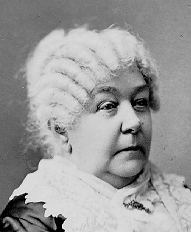Manifest destiny is a phrase that illustrates the belief of predestined westward expansion shared by many Americans in the 1800's. During the 1840's, an "expansion fever" took over the United States. Americans traveled and settled in the west due to trade,the prospect of new life, the escape of persecution, the inexpensive land, and manifest destiny.
From 1821 through the 1860's, traders and settlers loaded their wagons and set off toward the west. One of the busiest routes was the
Santa Fe Trail, which went from Independence, Missouri, to Santa Fe, New Mexico. This trail was mainly occupied with traders.
Another route used to travel to the west was the
Oregon Trail, which was blazed in 1836. This trail started in Independence, Missouri, and ended in Oregon City, Oregon. Many pioneers used this trail to escape the economic problems in the east and migrate to the west in search for a new life.
One group of people, called the Mormons, used the Oregon Trail and migrated west in order to escape persecution. Faced with anti-Mormon mobs in Ohio and Illinois, the Mormons decided to move farther west. In the end, the Mormons settled in a desert near the Great Salt Lake. By irrigating the land, the desert transformed into settlements and farms. This desert is now known as Salt Lake City.
Some Americans also settled in Texas, a Mexican region at the time, because of the inexpensive land. In 1821, a settler by the name of Stephen F. Austin established a colony in Texas where "no drunkard, no gambler, no profane swearer, and no idler" would be allowed. This colony, named San Felipe de Austin, consisted of three hundred families. As more Americans settled in Texas, the number of Anglo, or English-speaking, people surpassed the number of Mexicans. By 1830 there were more than 20,000 Americans in Texas.
This prodigious number of Anglo settlers, along with the instability of Mexican politics, created a "great" opportunity for the American government. Due to the unstable government, a rebellion broke out in Texas called the
Texas Revolution. In the end of this revolution, Texas gained independence from Mexico. After their independence, most Texans wanted the United States to annex the Texan republic.
The annexation angered the Mexican government, and President Polk, the president of the United States at that time, saw this anger as a great opportunity to gain more land in the west and fulfill the the prophesy of manifest destiny. By provoking the Mexican government, the United States was able to declare war on Mexico. After a year of fighting, Mexico conceded defeat. On February 2, 1848, the
Treaty of Guadalupe Hidalgo was signed, confirming the borderline between the United States and Mexico and giving the territories of New Mexico and California to the United States in exchange for $15 million.
However, this was not the end of the exchanges of land for money. Five years later, Mexico was paid $10 million for another piece of territory. This purchase was called the
Gadsden Purchase. With the new territory, the construction of the transcontinental railroad was made possible. Also, the current borders of the 48 states was established. Finally, the United States reached from "sea to shining sea."
By Angela





